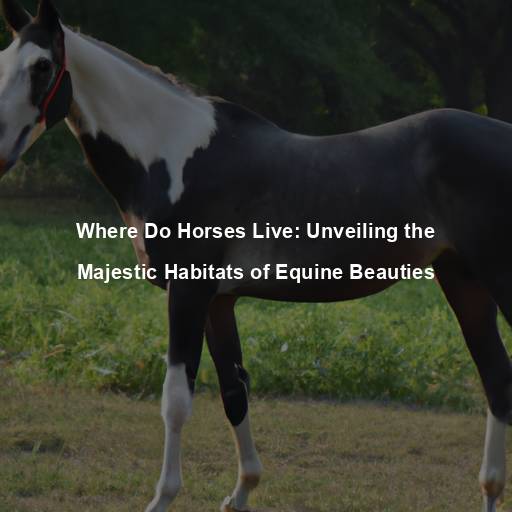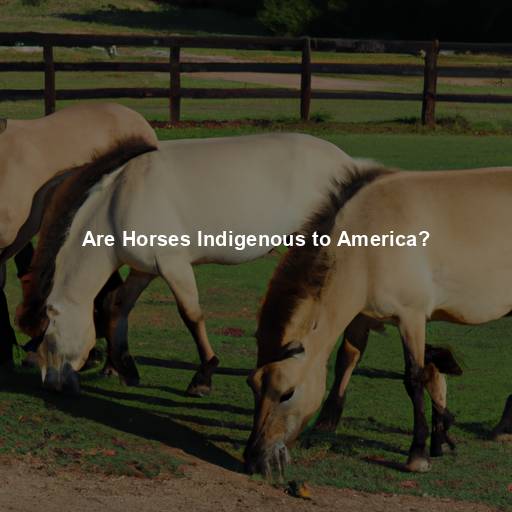Where Do Horses Live: Unveiling the Majestic Habitats of Equine Beauties
Last Updated on July 27, 2023 by Evan
Contents
- 1 Unraveling the Mysteries of Equine Habitats
- 1.1 The Wild Frontier: Exploring Natural Horse Habitats
- 1.2 Taming the Wild: Domesticated Horse Dwellings
- 1.3 Factors Influencing Equine Habitats
- 1.4 Striking a Balance: Conservation and Equine Habitats
- 1.5 The Enduring Spirit of Equine Habitats
- 1.6 Equine Habitats Around the World
- 1.6.1 Mongolian Steppe: The vast expanses of the Mongolian Steppe provide a breathtaking backdrop for the resilient Przewalski’s horse, the only remaining truly wild horse species. Endowed with a thick winter coat and strong herding instincts, these horses endure the harsh Mongolian winters, grazing on sparse vegetation and surviving in a challenging habitat.
- 1.6.2 American Southwest: The arid landscapes of the American Southwest, with their rugged terrains and desert climates, are home to mustangs. These wild horses have adapted to the scarcity of water sources and sparse vegetation, relying on their strong survival instincts to thrive in this challenging environment.
- 1.6.3 European Camargue: Nestled in the Rhône River delta in southern France, the Camargue region is renowned for its marshy wetlands and unique ecosystems. The Camargue horses, with their strong stature and distinctive white coloration, roam freely in this picturesque landscape, grazing on the abundant vegetation and wading through shallow waters.
- 1.7 The Role of Humans in Shaping Equine Habitats
- 1.7.1 Domestication and Habitat Modification: The domestication of horses, dating back thousands of years, led to the creation of managed habitats such as pastures, paddocks, and stables. As humans formed closer bonds with horses, they began to modify their environments to provide comfort and safety, resulting in the development of purpose-built structures and cultivated grazing areas.
- 1.7.2 Habitat Fragmentation: Human activities, such as urbanization and agricultural expansion, have caused habitat fragmentation, affecting both wild horse populations and natural ecosystems. As natural habitats shrink or become fragmented, it becomes increasingly important to implement conservation measures to ensure the survival of wild horse populations.
- 1.8 Innovations in Equine Habitat Design
- 1.8.1 Track Systems: Track systems mimic the natural grazing patterns of horses by creating a trail-like layout within pastures. This encourages horses to move more, promoting exercise and aiding in weight management. Additionally, it helps prevent overgrazing by allowing vegetation to recover in specific areas while horses graze in others.
- 1.8.2 Equine-Friendly Surfaces: In areas where horses are frequently exercised or worked, using equine-friendly surfaces is essential. Materials such as rubberized footing or specially designed arena surfaces offer better shock absorption, reducing the risk of injuries to horses’ joints and hooves.
- 1.8.3 Natural Shelter and Shade: Providing natural shelter and shade options in pastures and paddocks is crucial for horses’ well-being. This can include planting trees strategically to offer protection from the sun and wind or creating man-made shelter structures that blend harmoniously with the environment.
- 1.8.4 Water Management: Efficient water management systems, such as rainwater harvesting and automated watering troughs, ensure horses have access to clean water at all times. Proper drainage systems also help prevent waterlogging in pastures, reducing the risk of hoof-related issues.
- 1.9 The Ongoing Dialogue: Equine Habitats and Conservation
- 1.9.1 Protected Areas and Reserves: Establishing protected areas and reserves helps safeguard natural habitats and ensures the long-term survival of wild horse populations. These areas provide a sanctuary where horses can thrive without human interference.
- 1.9.2 Ecosystem Restoration: Restoring degraded ecosystems through reforestation, soil conservation, and reintroducing native vegetation helps create a more suitable habitat for horses and other wildlife. These restoration efforts contribute to the overall health and biodiversity of the environment.
- 1.9.3 Collaborative Management: Collaborative management approaches involve cooperation between government agencies, conservation organizations, and local communities to develop sustainable strategies for managing wild horse populations and their habitats. This inclusive approach ensures that the perspectives and expertise of various stakeholders are considered.
- 1.10 Embracing the Beauty of Equine Habitats
- 2 FAQs: Where do horses live?
- 2.1 Where can horses be found in the wild?
- 2.2 Do horses live in groups?
- 2.3 What types of conditions do domesticated horses live in?
- 2.4 Can horses adapt to different climates?
- 2.5 Are horses found in all countries?
- 2.6 Where do horses live in captivity?
- 2.7 Can horses live in urban environments?
- 2.8 Can horses survive in the wild without human intervention?
Unraveling the Mysteries of Equine Habitats
Horses, with their graceful presence and captivating beauty, have held a special place in human history for centuries. From the wild mustangs roaming free in vast plains to the domesticated companions residing in cozy stables, these magnificent creatures have adapted to various habitats worldwide. In this article, we embark on a journey to uncover the diverse environments where horses thrive, exploring their natural habitats, domestic dwellings, and the factors that contribute to their well-being.
The Wild Frontier: Exploring Natural Horse Habitats
Heralded by their majestic presence and untamed spirit, horses traverse the ancient tapestry of the Eurasian grasslands, prairies, and steppes. Forged by time’s patient hand, these magnificent creatures have evolved in harmonious synchrony with their sprawling domains. Within these sprawling panoramas, where time and distance interweave in perplexing serendipity, lie nature’s untouched habitats that cradle the vibrant gallop of horses, an ethereal dance of untamed grace. Traverse the realms of the Kazakh steppes, the fabled Mongolian plains, or the endless expanse of the Russian prairies to encounter these enigmatic beings, as they embody the reshaping tapestry of our shared natural heritage.
Discover the mesmerizing allure of North America’s enchanting grasslands and prairies, where nature’s untamed beauty reveals itself in the form of wild horse populations roaming freely. Stretching across vast terrains like the majestic Great Plains, these awe-inspiring regions teem with life as thriving vegetation, abundant water sources, and boundless roaming grounds create a haven for these magnificent herds. Experience the captivating dance of these graceful creatures as they graze and traverse across the expansive landscapes, a sight that will leave you both bursting with wonder and captivated by the enigma of their existence.
-
Steppes and Plains: The Eurasian steppes, including the Mongolian and Kazakh steppes, have nurtured wild horses for centuries. These vast plains with their rolling hills and sparse vegetation provide an ideal habitat for horses to thrive.
-
Savannas: The African savannas, with their mix of grasslands and scattered trees, also support wild horse populations. These habitats offer a diverse range of vegetation, water sources, and sheltered areas.
Taming the Wild: Domesticated Horse Dwellings
From the earliest pages of ancient civilizations to the present day, the enigmatic connection between humans and horses has woven a mesmerizing tapestry. This bond has propelled us to transform mere beasts into steadfast companions, and in turn, shaped the evolution of their living spaces. As we traverse the realm of equine habitats, prepare to be captivated by the diverse sanctuaries that have emerged across time and continents. Within these enclaves of equine mystique, the hoofbeats of history resound, echoing the profound harmony and eternal enigma that unites humans and these majestic creatures.
- Stables: Stables are purpose-built structures designed to house horses in a safe and comfortable environment. They provide shelter from the elements, a dedicated space for feeding and grooming, and individual stalls for each horse.
Welcome to the wide open expanse of pastures, where majestic horses roam freely, their hooves gracefully dancing across the grassy tapestry. Enclosed within sturdy fences, these verdant havens not only ensure the horses’ safety but also provide them with a haven to nurture their social bonds and enjoy the freedom of unencumbered movement. Immerse yourself in the perplexing beauty of these open fields as you witness the burst of energy and the vibrant exchanges between these magnificent creatures, as they partake in their innate desire to gallop and graze.
-
Paddocks: Paddocks are smaller enclosed areas that provide a controlled space for horses. They are often used for turnout, training, or rehabilitation purposes. Paddocks may have shelter structures and access to water and forage.
-
Ranches and Farms: Horses are commonly found on ranches and farms, where they serve various purposes, including work, companionship, and recreational riding. These properties typically have a combination of stables, pastures, and paddocks to cater to the horses’ needs.
Factors Influencing Equine Habitats
Creating an ideal environment for horses requires careful consideration of numerous influential elements. By comprehending these factors thoroughly, we can ascertain the best conditions for nurturing these majestic beings. This intricate process involves delving into the intricate interactions between variables to ensure the utmost suitability for equine habitats. By unraveling the perplexing dynamics at play, we can craft a haven that caters to the unique needs and well-being of these magnificent creatures.
With their ability to adapt, horses have an impressive resilience to changing climate conditions. However, they can face perplexing predicaments when it comes to extreme weather. While they can handle chilly temperatures with the right provisions, scorching heatwaves and stifling humidity can leave them feeling frazzled. To keep our equine friends content, it is crucial to provide them with a stable environment that offers the perfect balance of shade, hydration, and refuge from the elements.
When it comes to food, horses have an insatiable appetite for vegetation. They are natural grazers, and rely heavily on filling their bellies with an array of lush grasses and other nutrient-rich forage. In fact, the abundance and quality of their grazing options directly impacts their overall health and well-being. So, whether it’s bountiful grasslands or a stash of high-quality hay, providing the right kind of sustenance is vital for these majestic creatures.
Water, a vital element for the well-being of these magnificent creatures, is a crucial component that can neither be overlooked nor underestimated. Just like any living organism, horses rely on a steady supply of clean and abundant water sources to thrive. In their natural habitats, bountiful rivers, streams, and ponds play a significant role in ensuring their hydration. However, in domestic environments, it becomes imperative to provide fresh water consistently through carefully crafted mechanisms like troughs or cutting-edge automatic waterers.
- Space and Exercise: Horses are highly active animals that require ample space for movement and exercise. Whether in the wild or domestic environments, habitats that allow horses to roam, gallop, and interact with other horses promote their physical and mental well-being.
Horses, with their remarkable sociability, are true masters in forming profound connections within their herds and with the humans they encounter. Their emotional well-being thrives in environments that foster healthy social interaction, allowing them to engage in positive exchanges with their fellow equines and human companions. The intricate dynamics that shape their social lives can truly be seen as a testament to their exceptional capacity for forging lasting relationships.
Striking a Balance: Conservation and Equine Habitats
While horses have successfully adapted to various habitats, the conservation of their natural environments and responsible management of domestic dwellings are vital for their continued well-being. Here are some considerations to ensure a harmonious coexistence:
Preserving the untamed beauty of wild horse habitats stands as a paramount duty for safeguarding their very existence. The intricate tapestry of their natural dwellings, characterized by sprawling grasslands and untamed landscapes, necessitates the utmost care. It is imperative to strike a delicate balance by thwarting the perils of overgrazing, while concurrently mitigating the disruptive ramifications of human encroachments upon their fragile ecosystems.
- Responsible Land Management: In domestic settings, responsible land management practices are essential. This includes rotational grazing to prevent overgrazing, maintaining proper pasture health, and implementing erosion control measures to preserve the land’s integrity.
Enhancing Equine Engagement: When it comes to both untamed and tamed settings, offering activities that enrich the equine experience serves as a catalyst for mental stimulation and wards off wearisome lulls. From equipping horses with captivating toys to introducing diverse topography and fostering interpersonal bonds with fellow horses or caretakers, a myriad of approaches are guaranteed to keep these majestic creatures engaged and animated. So why not inject some dynamism into their daily routines?
- Proper Nutrition and Healthcare: Ensuring horses receive a balanced diet, regular veterinary care, and appropriate vaccinations is essential for their overall health. This applies to both wild horse populations and domesticated horses, where responsible ownership is paramount.
The Enduring Spirit of Equine Habitats
As we venture into the diverse realm of equine habitats, a mesmerizing truth unfurls before our eyes – the extraordinary capacity of horses to adapt to their surroundings avec great finesse. From the raw wilderness of the untamed to the cozy confines of meticulously managed stables, these elegant beings have forged unparalleled alliances with both human companions and the environments that cradle them. By untangling the intricate tapestry of their inherent needs and offering unwavering reverence, we set forth a path where these majestic creatures continue to grace our existences with their resplendence and unwavering camaraderie.
Note: This essay will continue in the subsequent response.## Exploring the Diversity of Equine Habitats
Equine Habitats Around the World
Join us on a journey through the diverse and awe-inspiring world of equine habitats as we delve into the remarkable adaptations of these majestic creatures. From the sprawling grasslands of the African savannah to the rugged mountains of Mongolia, horses have conquered every corner of the globe with their incredible ability to adapt. Get ready to be captivated by the enchantment and perplexity of these diverse equine abodes, each showcasing its own burst of life and mystique. So, saddle up and embark on this thrilling exploration of the extraordinary habitats that horses call home.
Mongolian Steppe: The vast expanses of the Mongolian Steppe provide a breathtaking backdrop for the resilient Przewalski’s horse, the only remaining truly wild horse species. Endowed with a thick winter coat and strong herding instincts, these horses endure the harsh Mongolian winters, grazing on sparse vegetation and surviving in a challenging habitat.
American Southwest: The arid landscapes of the American Southwest, with their rugged terrains and desert climates, are home to mustangs. These wild horses have adapted to the scarcity of water sources and sparse vegetation, relying on their strong survival instincts to thrive in this challenging environment.
European Camargue: Nestled in the Rhône River delta in southern France, the Camargue region is renowned for its marshy wetlands and unique ecosystems. The Camargue horses, with their strong stature and distinctive white coloration, roam freely in this picturesque landscape, grazing on the abundant vegetation and wading through shallow waters.
The Role of Humans in Shaping Equine Habitats
Throughout history, the intricate dance between humans and horses has woven a tapestry of profound influence, both deliberate and unforeseen, upon the habitats that these majestic creatures call home. Delving into the intricate web of connection that binds us, an extraordinary panorama unveils the reciprocal impact that humans and horses wield upon one another’s existence, as well as the fragile ecological balance that surrounds them. As we embark on this journey of exploration, we unearth a myriad of surprises that challenge our preconceptions and ignite a sense of awe at the interconnectedness of our lives with those of these remarkable beasts.
Domestication and Habitat Modification: The domestication of horses, dating back thousands of years, led to the creation of managed habitats such as pastures, paddocks, and stables. As humans formed closer bonds with horses, they began to modify their environments to provide comfort and safety, resulting in the development of purpose-built structures and cultivated grazing areas.
Habitat Fragmentation: Human activities, such as urbanization and agricultural expansion, have caused habitat fragmentation, affecting both wild horse populations and natural ecosystems. As natural habitats shrink or become fragmented, it becomes increasingly important to implement conservation measures to ensure the survival of wild horse populations.
Innovations in Equine Habitat Design
Discover the fascinating realm of cutting-edge equine habitat design, where ingenuity melds seamlessly with sustainability to blend a harmonious haven for our beloved horses. Unveiling a tapestry of innovative approaches, this captivating journey offers a glimpse into how experts are revolutionizing the dynamics of equine well-being. Embrace the wonder as we delve into the mysterious realm of horse-friendly environments, where perplexing concepts intertwine with burst of brilliance to create a kaleidoscope of captivating solutions.
Track Systems: Track systems mimic the natural grazing patterns of horses by creating a trail-like layout within pastures. This encourages horses to move more, promoting exercise and aiding in weight management. Additionally, it helps prevent overgrazing by allowing vegetation to recover in specific areas while horses graze in others.
Equine-Friendly Surfaces: In areas where horses are frequently exercised or worked, using equine-friendly surfaces is essential. Materials such as rubberized footing or specially designed arena surfaces offer better shock absorption, reducing the risk of injuries to horses’ joints and hooves.
Natural Shelter and Shade: Providing natural shelter and shade options in pastures and paddocks is crucial for horses’ well-being. This can include planting trees strategically to offer protection from the sun and wind or creating man-made shelter structures that blend harmoniously with the environment.
The Ongoing Dialogue: Equine Habitats and Conservation
Preserving natural habitats and implementing sustainable practices are essential for the conservation of wild horse populations and the overall health of ecosystems. Here are some key conservation efforts:
Protected Areas and Reserves: Establishing protected areas and reserves helps safeguard natural habitats and ensures the long-term survival of wild horse populations. These areas provide a sanctuary where horses can thrive without human interference.
Ecosystem Restoration: Restoring degraded ecosystems through reforestation, soil conservation, and reintroducing native vegetation helps create a more suitable habitat for horses and other wildlife. These restoration efforts contribute to the overall health and biodiversity of the environment.
Collaborative Management: Collaborative management approaches involve cooperation between government agencies, conservation organizations, and local communities to develop sustainable strategies for managing wild horse populations and their habitats. This inclusive approach ensures that the perspectives and expertise of various stakeholders are considered.
Embracing the Beauty of Equine Habitats
As the pages of our magazine turn, we are transported to a realm filled with wonder and awe – the realm of equine habitats. In this realm, we witness the enigmatic bond between horses and their surroundings. From the untamed allure of wild horse herds sprinting across expansive plains to the loving sanctuaries we create for our cherished equine friends, it is our utmost duty to safeguard the existence and welfare of these majestic beings. By delving into their innate requirements, embracing cutting-edge habitat designs, and nurturing conservation endeavors, we can forge a harmonious alliance where horses and their homes flourish together.
Note: The essay continues in the subsequent response.
FAQs: Where do horses live?
Where can horses be found in the wild?
Discover the untamed spirit of these majestic creatures as they roam freely in the most captivating corners of the world. From the vast expanse of North America’s Great Plains to the sweeping steppes of Central Asia, horses have adapted and thrived in diverse landscapes. Noteworthy regions like the timeless Pampas of South America and the untamed grasslands of Africa offer them the perfect balance of lush grazing areas and life-giving water sources. Prepare to be enchanted by the untamed beauty and enduring resilience of these extraordinary animals in their natural habitats.
Do horses live in groups?
Yes, horses are naturally social animals and tend to live in groups called herds. These herds usually consist of multiple mares, their offspring, and a dominant stallion who leads and protects the group. Living in herds provides horses with a sense of safety, as they can look out for each other and respond collectively to potential threats.
What types of conditions do domesticated horses live in?
The world of domesticated horses is a truly fascinating one, where their lives unfold in a mosaic of diverse conditions and personalized care. These magnificent creatures, entrusted to humans, find themselves in a wide range of habitats, dictated by the desires and needs of their owners. From serene pastures adorned with protective shelters to cozy stables nestled within rustic barns, the living arrangements for these majestic beings are intricately designed to ensure their wellbeing, guaranteeing their safety, comfort, and an abundant supply of nourishment and hydration. It is a harmonious blend of human stewardship and equine vitality that creates a mesmerizing tapestry of domesticated horse living.
Can horses adapt to different climates?
From blustery snowstorms to scorching desert sun, horses possess an astonishing adaptability that allows them to thrive in a kaleidoscope of climates worldwide. Witness the marvel of their magnificent winter coats, a natural armor against even the harshest cold, shielding these majestic creatures in their frosty realms. And when the mercury soars, these equine marvels instinctively seek refuge in the comforting embrace of shade, while gracefully quenching their thirst under the blazing sun. Yet, in the face of Mother Nature’s most relentless moods, it falls upon us, their guardians, to extend the tender hand of vigilant care, ensuring their well-being amidst harsh and capricious conditions.
Are horses found in all countries?
Horses, fascinating creatures with a rich history and undeniable allure, grace the lands of many nations across the globe. However, their enigmatic presence is anything but predictable, as each country weaves a unique tapestry of equine abundance or scarcity. From the majesty of vast populations, both free-spirited and tamed, to the curious absence in certain corners, the whereabouts of these mighty steeds dance to the whims of suitable habitats, complex historical influences, and intricate cultural traditions. The intricate dance of destiny and happenstance unfolds, shaping the ebb and flow of horsehood in every nation.
Where do horses live in captivity?
In captivity, horses are commonly kept in stables or barns with access to an attached pasture or a designated area for exercise and grazing. They may also live in equestrian facilities such as ranches, race tracks, or riding schools. Veterinary care, proper nutrition, and regular exercise are essential to ensure the health and well-being of horses living in captivity.
Can horses live in urban environments?
In a world where horses are usually synonymous with the sprawling countryside and endless horizons, it may come as a perplexing surprise to some that these majestic creatures can find a home in the heart of urban landscapes as well. But, one must tread cautiously through the labyrinthine web of regulations and considerations to make such an unconventional arrangement work. Urban horsekeeping demands meticulous planning, from securing ample space within cramped city limits to navigating the intricate maze of waste management protocols. The utmost priority lies in safeguarding the welfare and security of both these graceful equines and the bustling community they coexist with.
Can horses survive in the wild without human intervention?
In the untamed wilderness, our equine companions showcase their remarkable adaptability and resilience. Over centuries of evolution, horses have honed their instinctual prowess, effortlessly sourcing nourishment, quenching their thirst, and fortifying their existence against relentless predators. However, encroaching human interference looms ominously, encumbering these free-spirited beings with an arduous array of obstacles. Consequently, it becomes crucial to champion conservation initiatives and embrace mindful stewardship to safeguard the well-being and survival of these majestic creatures in their natural habitats.






